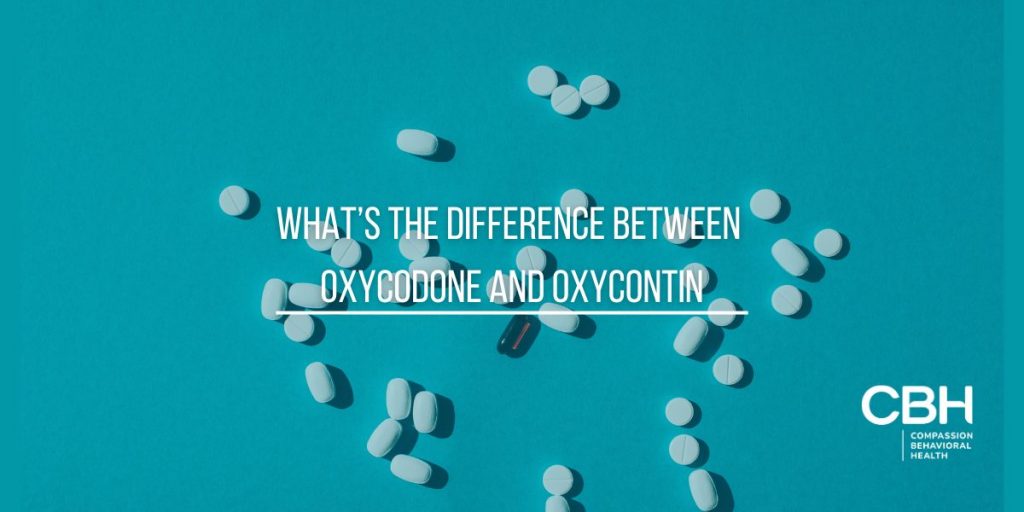Oxycodone and OxyContin are two prescription medications that are commonly used to treat pain. While they share some similarities, they also have several key differences that set them apart. This article will provide an in-depth comparison of Oxycodone and OxyContin, including their chemical composition, indications, side effects, dosage, and administration.
Oxycodone vs. OxyContin
What is Oxycodone?
Oxycodone is an opioid pain medication that is derived from thebaine, a natural alkaloid that is found in opium poppy plants. It works by binding to specific receptors in the brain and spinal cord to reduce the sensation of pain. Oxycodone is available in both immediate-release and extended-release formulations and is commonly used to treat moderate to severe pain.
Oxycodone is a Schedule II controlled substance, which means that it has a high potential for abuse and addiction. Because of this, it is only available with a prescription from a licensed healthcare provider. It is important to take oxycodone exactly as prescribed and to not share it with others.
Common side effects of oxycodone include constipation, nausea, dizziness, and drowsiness. More serious side effects can include difficulty breathing, chest pain, and seizures. If you experience any of these side effects, contact your healthcare provider immediately.
What is OxyContin?
OxyContin is a brand name of extended-release oxycodone. It is designed to provide long-lasting pain relief by slowly releasing oxycodone over a 12-hour period. OxyContin is prescribed for pain that is expected to last for an extended period and cannot be managed by other medications.
Like oxycodone, OxyContin is a Schedule II controlled substance and has a high potential for abuse and addiction. It is important to take OxyContin exactly as prescribed and to not share it with others.
OxyContin has been the subject of controversy in recent years due to its potential for abuse. In response, the manufacturer has developed a new formulation of the drug that is more difficult to abuse. However, it is still important to use OxyContin only as prescribed and to be aware of the potential for addiction.
If you are prescribed oxycodone or OxyContin, it is important to talk to your healthcare provider about any concerns you may have and to follow their instructions carefully. With proper use, these medications can provide effective pain relief for those who need it.
Chemical Composition and Formulation
Active Ingredients in Oxycodone and OxyContin
Oxycodone and OxyContin are two medications that are commonly used for pain management. The active ingredient in both Oxycodone and OxyContin is oxycodone hydrochloride. This chemical compound is a powerful opioid analgesic that works by binding to specific receptors in the brain and spinal cord to decrease the perception of pain.
Oxycodone hydrochloride is a white, odorless, crystalline powder that is soluble in water. It is classified as a Schedule II controlled substance by the Drug Enforcement Administration (DEA) due to its high potential for abuse and dependence.
However, the formulations of the two medications differ. Immediate-release oxycodone is formulated as a single-agent product, whereas OxyContin is formulated as a controlled-release tablet that delivers oxycodone over an extended period of time.
Extended-Release vs. Immediate-Release Formulations
The extended-release formulation of OxyContin is designed to provide a steady, controlled release of oxycodone over time. This means that patients can take fewer doses per day and experience more consistent pain relief than they would with immediate-release oxycodone.
However, extended-release formulations also carry a higher risk of abuse and addiction than immediate-release medications. The controlled-release mechanism can be bypassed by crushing or chewing the tablets, which releases a large amount of oxycodone all at once. This can lead to a rapid onset of euphoria and a higher risk of overdose.
It is important for healthcare providers to carefully consider the risks and benefits of prescribing extended-release opioids like OxyContin. They should also monitor patients closely for signs of abuse or addiction, and provide education on safe storage and disposal of unused medications.
Overall, the chemical composition and formulation of Oxycodone and OxyContin play a crucial role in their effectiveness and potential for abuse. By understanding these factors, healthcare providers can make informed decisions about pain management and help prevent opioid misuse and addiction.
Uses and Indications
Medical Uses of Oxycodone
Oxycodone is a powerful opioid medication that is commonly prescribed to relieve moderate to severe pain. How long it takes Oxydone to work depends on various factors, but usually, immediate-release oxycodone kicks in within 15 to 30 minutes. It works by binding to specific receptors in the brain and spinal cord, which reduces the sensation of pain.
Due to its effectiveness, oxycodone is often prescribed following surgery, injury, or for chronic pain conditions such as cancer or arthritis. It can provide much-needed relief for patients who are struggling with pain that is interfering with their daily lives.
While oxycodone can be highly effective for pain relief, it is important to note that it can also be highly addictive. As a result, it should only be used under the close supervision of a healthcare provider, and patients should be carefully monitored for signs of addiction or misuse.
Medical Uses of OxyContin
OxyContin is a brand-name version of oxycodone that is specifically formulated for extended-release. This means that the medication is released slowly over time, providing long-lasting pain relief for patients with chronic pain conditions.
Like oxycodone, OxyContin is a powerful opioid medication that is used to relieve moderate to severe pain. However, it is generally reserved for patients with chronic pain that requires long-term opioid treatment. It is not intended for use on an as-needed basis for short-term pain relief.
While OxyContin can be highly effective for managing chronic pain, it also carries a high risk of addiction and dependence. As a result, it should only be used under the close supervision of a healthcare provider, and patients should be carefully monitored for signs of addiction or misuse.
It is important for patients to be aware of the potential risks and benefits of using OxyContin, and to work closely with their healthcare provider to determine if it is the right choice for their individual needs.
Side Effects and Risks
Common Side Effects of Oxycodone
The most common side effects of oxycodone include constipation, nausea, sedation, and respiratory depression. Some patients may also experience dizziness, headache, and confusion. Long-term use of oxycodone may also lead to tolerance, dependence, and addiction.
Common Side Effects of OxyContin
Like Oxycodone, OxyContin can cause constipation, nausea, sedation, and respiratory depression. It may also cause dry mouth, headache, and dizziness. Because of its extended-release formulation, patients taking OxyContin may experience less fluctuation in pain control than those taking immediate-release oxycodone.
Potential for Addiction and Overdose
Both Oxycodone and OxyContin have a high potential for abuse and addiction, particularly when used improperly or in higher-than-prescribed doses. Overdose on either medication can lead to respiratory depression, coma, and even death.
Dosage and Administration
Oxycodone Dosage Guidelines
The dosage of oxycodone will depend on the patient’s individual needs, pain severity, and medical history. It is typically started at a low dose and increased gradually as needed. Immediate-release formulations are typically taken every four to six hours, while extended-release formulations may be taken every 12 hours.
OxyContin Dosage Guidelines
OxyContin is also prescribed at individualized doses based on the patient’s pain severity and medical history. It is taken every 12 hours and should not be taken with any other opioids, sedatives, or alcohol. Patients should not crush, chew, or break OxyContin tablets, as this can lead to a rapid release of the medication and an increased risk of overdose.
Converting Between Oxycodone and OxyContin
Patients who are taking immediate-release oxycodone may be switched to OxyContin for long-term pain management. The conversion between the two medications should be done under the guidance of a healthcare professional, who can ensure that the patient receives the proper dose of OxyContin for their pain severity.
Get Help For Substance Use Disorder In Florida
While Oxycodone and OxyContin share some similarities, they also have several differences that set them apart. Both medications are effective for relieving pain, but OxyContin is designed for long-term pain management and carries a higher risk of abuse and addiction. CBH is a Nationally Recognized treatment center located in Florida, offering true dual-diagnosis, evidence based treatment for patients suffering from substance use disorder and mental health. (844) 612-0444



